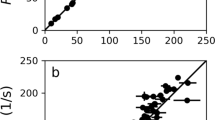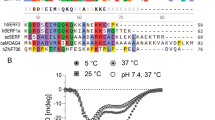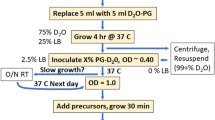Abstract
A gene encoding a protein classified as alanyl-tRNA synthetase (AlaRS) was found in the genome of the psychrophilic bacteria Bizionia argentinensis. The enzyme is constituted by three domains with an evolutionarily conserved modular arrangement: the N-terminal aminoacylation domain, the editing domain and the C-terminal domain (C-Ala). Herein we report the near complete NMR resonance assignment of the 122 amino acid C-Ala domain from B. argentinensis. The chemical shift data, reported for the first time for a C-Ala domain, constitute the basis for NMR structural studies aimed at elucidating the cold-adaptation mechanism of AlaRS.


Similar content being viewed by others
References
Arnold K, Bordoli L, Kopp J, Schwede T (2006) The SWISS-MODEL workspace: a web-based environment for protein structure homology modelling. Bioinformatics 22:195–201
Bercovich A, Vazquez SC, Yankilevich P et al (2008) Bizionia argentinensis sp. nov., isolated from surface marine water in Antarctica. Int J Syst Evol Microbiol 58:2363–2367
Bernardet JF, Nakagawa Y (2006) An introduction to the family Flavobacteriaceae. In: Dworkin M, Falkow S, Rosenberg E, Schleifer KH, Stackebrandt E (eds) The prokaryotes: a handbook on the biology of bacteria, vol 7, 3rd edn. Springer, New York, pp 455–480
Bernardet JF, Segers P, Vancanneyt M, Berthe F, Kersters K, Vandamme P (1996) Cutting a Gordian knot: emended classification and description of the genus Flavobacterium, emended description of the family Flavobacteriaceae, and proposal of Flavobacterium hydatis nom. nov. (Basonym, Cytophaga aquatilis Strohl and Tait 1978). Int J Syst Bacteriol 46:128–148
Bernardet JF, Nakagawa Y, Holmes B (2002) Proposed minimal standards for describing new taxa of the family Flavobacteriaceae and emended description of the family. Int J Syst Evol Microbiol 52:1049–1070
Bowman JP (2000) Description of Cellulophaga algicola sp. nov., isolated from the surfaces of Antarctic algae, and reclassification of Cytophaga uliginosa (ZoBell and Upham 1944) Reichenbach 1989 as Cellulophaga uliginosa comb. nov. Int J Syst Evol Microbiol 50:1861–1868
Bowman JP, Nichols DS (2002) Aequorivita gen. nov., a member of the family Flavobacteriaceae isolated from terrestrial and marine Antarctic habitats. Int J Syst Evol Microbiol 52:1533–1541
Guo M, Chong YE, Beebe K, Shapiro R, Yang XL, Schimmel P (2009) The C-Ala domain brings together editing and aminoacylation functions on one tRNA. Science 325:744–747
Johnson B, Blevins RA (1994) NMRView: a computer program for the visualization and analysis of NMR data. J Biomol NMR 4:603–614
Lanzarotti E, Pellizza L, Bercovich A et al (2011) Draft genome sequence of Bizionia argentinensis, isolated from Antarctic surface water. J Bacteriol 193(23):6797–6798
Ribas De Pouplana L, Musier-Forsyth K, Schimmel P (2005) Alanyl tRNA synthetases. In: Ibba M, Francklyn C, Cusak S (eds) Aminoacyl tRNA synthetases. Landes Biosciences, Eurekah.com, Georgetown, TX, pp 241–249
Shen Y, Bax A (2010) SPARTA+: a modest improvement in empirical NMR chemical shift prediction by means of an artificial neural network. J Biomol NMR 48:13–22
Shen Y, Delaglio F, Cornilescu G, Bax A (2009) TALOS+: a hybrid method for predicting protein backbone torsion angles from NMR chemical shifts. J Biomol NMR 44:213–223
Viiri J, Amadio M, Marchesi N et al (2013) Autophagy activation clears ELAVL1/HuR-mediated accumulation of SQSTM1/p62 during proteasomal inhibition in human retinal pigment epithelial cells. PLoS One 8(7):e69563
Yi H, Oh HM, Lee JH, Kim SJ, Chun J (2005) Flavobacterium antarcticum sp. nov., a novel psychrotolerant bacterium isolated from the Antarctic. Int J Syst Evol Microbiol 55:637–641
Acknowledgments
C.S. acknowledges financial support by Fundación Bunge Born and the 2011 Cooperint Internationalization Program of the University of Verona.
Conflict of interest
The authors declare that they have no conflict of interest.
Author information
Authors and Affiliations
Corresponding authors
Rights and permissions
About this article
Cite this article
Smal, C., Zanzoni, S., D’Onofrio, M. et al. 1H, 15N and 13C chemical shift assignments of the C-Ala domain of the alanyl-tRNA synthetase of the psychrophilic bacterium Bizionia argentinensis sp. nov.. Biomol NMR Assign 8, 415–418 (2014). https://doi.org/10.1007/s12104-013-9529-8
Received:
Accepted:
Published:
Issue Date:
DOI: https://doi.org/10.1007/s12104-013-9529-8




